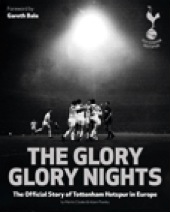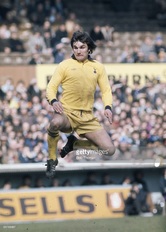 Whilst Tottenham have played in white shirts with navy blue shorts (or knickers as they were called till the late 1950’s) since 1898, the kit has evolved significantly over time with changes in fashion, practicality, technology and ultimately commercialism all having an impact on the design of the lilywhite shirt, evolving from the flannel/cotton button up shirts of Victorian times to today’s high tech, quick drying, moisture resistant, lightweight materials. With the resumption of football immediately after the war in August 1945, Spurs continued to use their pre-war plain white shirts, made by Umbroto a design they called Tangeru. These had been introduced in 1937, and sported the cockerel crest. Spurs had correctly read the impending signs of war during the summer of 1939 and had bought a job lot of new kits that they continued to use throughout the conflict and immediately after. Strangely though, in the first league game of that first post war season, which was still the Football League South, they are shown to have worn blue shirts with white knickers at home to Wolves, for which I can find no explanation. 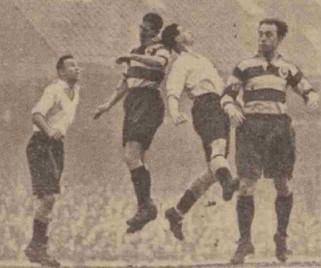 For the start of the following season (1946/47) and the recommencement of the Football League, Spurs initially played in plain white shirts without any crest. Two variants of this shirt were used, with varying depths of collar placket. Neither appear to have been made by Umbro and I can only assume that these were the only ones available in the post war austerity times when clothes rationing was still in place. However by April of 1947, the Umbro Tangeru shirts, with a crest, had returned and these continued to be used till the end of the 1950/51 Championship winning season. Top image - Away shirt 1976 -77 Right - Away shirt 1945 -47 For these two seasons immediately after the war, they had also continued to use the pre-war broad navy blue and white hooped shirts as a change kit, but from 1947, they introduced a red Umbro Tangeru change shirt with a white collar, a colour worn as a change, many times in their history, but which nowadays seems unbelievable. This was worn with either navy blue or white knickers. 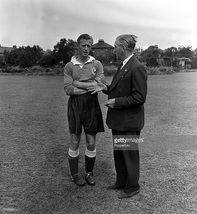 By the late 1940’s, clubs were beginning to appreciate that these heavy cotton long sleeved shirts were not necessarily the most appropriate wear in the warmer autumn and spring months of the season and Spurs began experimenting with lighter shirts that had deeper plackets, first seen in long sleeve form in the 1947/48 season and from 1949 with short sleeves. These continued to be worn as a warm weather option till 1956. Away shirt - 1947 -1950 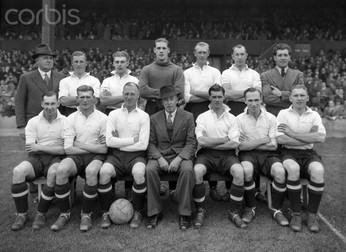 In the 1949/50 season another new Umbro Tangeru change shirt was introduced, this time navy blue with a white collar, matched with white knickers. Despite now having played in white shirts and navy blue knickers for over half a century, this was the first time that they had ever used a reversed combination as a change kit. This shirt replaced the red one, a colour which has never been worn since, at least by outfield players, though Tottenham goalkeepers continued to wear red as an alternative to green until the early ‘60’s. Right - Home kit 1946-47 without the cockerel. For the 1951/52 season, following their League Championship success, an updated slim-line cockerel badge was introduced onto both the existing long and short sleeved home shirts. Also at this time the knickers acquired a sheen, which I can only attribute to the material being changed from traditional thick cotton, to a lighter artificial fabric. These knickers were also more colour fast, so that there was no longer occasions when players lined up in old faded blue/grey knickers that had clearly lost their colour through numerous washes. 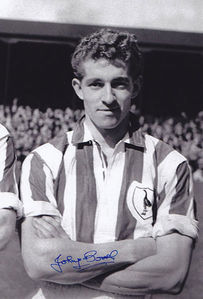 During the following season another new change shirt of navy blue and white vertical stripes, now featuring the new slim-line badge, was introduced. This does not appear to have been the standard Umbro Tangeru shirt of the period, but some form of light weight shirt mentioned earlier with a deeper placket, this was worn with navy blue or white knickers Away shirt - 1952 -57 At the start of the 1955/56 season, driven by the influence of the success on British shores of continental teams, Tottenham introduced home shirts made in lightweight cotton by Umbro, known colloquially as "continental" shirts but more correctly they were called “Tangeru Lightweight”. These remained plain white, had a newly fashionable inset V collar and short sleeves. These shirts were initially used in August and September, before the re-introduction of the older long sleeve shirt, for the winter months. They were then reintroduced for the FA Cup semi-final in March 1956, and used thereafter, finally consigning the old long sleeved shirts with button up collars to history. In conjunction with the new shirts, shorter shorts were also introduced, though some players, notably Danny Blanchflower, continued to wear the older, longer, baggier knickers. This kit was retained till the end of the 1958/59 season. There is one puzzling anomaly with this shirt however. For at least one game against Manchester United at Old Trafford in April 1957, this shirt sported the older pre 1951 crest. 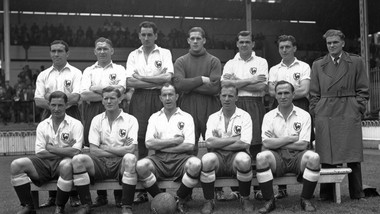 A corresponding short sleeved away shirt of navy blue with white collar and cuffs which was worn with white shorts was introduced in 1957. The mid ‘50’s saw the first regular use of floodlights in England and Spurs, along with other clubs, experimented with modified shirts for better visibility in the early primitive floodlights. In late 1956, florescent white shirts were worn in at least one floodlit match. Right - The Home shirt 1949-51, and the cockerel returns To continue this experiment, a dazzling change kit described as either all amber or all gold was worn in at least six matches between 1958 and 1960, as was a yellow kit with blue and white hoops in 1962, though I have never seen a photograph of either. None of these experimental kits proved to be satisfactory as the artificial material used tended to cling to the body when wet and proved uncomfortable for the players and were subsequently discarded. 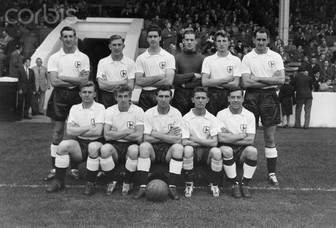 For the start of the 1959/60 season, Spurs introduced the shirt that would become famous during their glory days of the double wining period. Still produced by Umbro, these shirts had a simpler V neck design, and whilst these shirts were normally worn with the navy blue shorts and socks as before, it was whilst wearing these that Spurs played in their first European campaign and that the all-white “European kit” was introduced. There are conflicting reasons as to why; either manager Bill Nicholson wanted to emulate the great Real Madrid sides, or more pragmatically it was to improve visibility under floodlights, we shall probably never know which. Home - 1955 - 1959 This though was not the first appearance of the all-white kit, it had been worn at least once before in November 1959 against the Torpedo side of Moscow and white shirts and shorts had been worn as early as 1956 in a floodlit friendly against Racing Club of Paris. Although some players, notably Jimmy Greaves, still preferred slightly longer shorts till the mid ‘60’s, 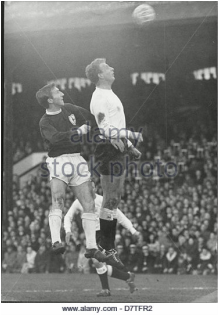 it was also around this time that the shorts finally reached their shortest, and they stayed this way till Tottenham changed fashion again with the re-introduction of long shorts in the 1991 FA Cup Final. In 1957, lightweight Terylene socks began replacing the old heavy woollen stockings and it would appear that these were initially made for Spurs by Litesome, despite the rest of the kit being made by Umbro. In these days before commercial contracts were in place, the kit was normally supplied to the club by a local sports retailer and they would source to suppliers with whom they had a contract. In Spurs’ case, Geo. Elsey & Son who had a sports shop on the Tottenham High Road. 1959 also saw the introduction of plain navy blue away shirt, with a navy blue polo collar, but with a larger crest than usual and a large white patch on its back for the number. This in turn gave way after only one season to an away shirt of identical design to that of the double winning home shirt in navy blue with a white V neck and cuffs. Both of these shirts were worn with white shorts. right - Away shirt 1962 -67 below - Away shirt 1967-69 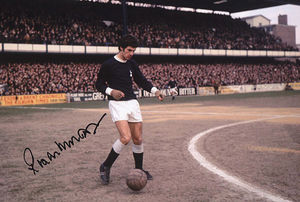 For the start of Tottenham’s 1962/63 European Cup Winner's Cup campaign with the match against Rangers on the 31st October, they again moved with the fashion and a new long sleeved, crew necked Umbro Aztec cotton shirt was introduced. This shirt initially sported the slim line cockerel crest that had been introduced in 1951, but from August of 1966 it sported an updated crest of the cockerel on a football that had adorned the top of the West Stand since 1909. This crest though had made an initial appearance on the shirt in two games (Leicester City and Liverpool) early in the preceding 1965/66 season. This shirt was worn with navy blue shorts and socks in League matches and all white shorts and socks in all European matches and for the 1967 and 1968 FA Cup campaigns, with white socks being introduced domestically from the start of the 1967/68 season. These shirts continued to be worn till the summer of 1977, with the only changes being a larger crest for the 1975/76 season and from 1975 the addition of an Umbro logo on the right breast. The larger crest was at the behest of the then new manager Terry Neill whose idea was “to give the old Cockspur a lift”. As he quoted, “We have a unique emblem, and should all be proud of the great traditions the cockerel represents, ours is more than just another white shirt”. 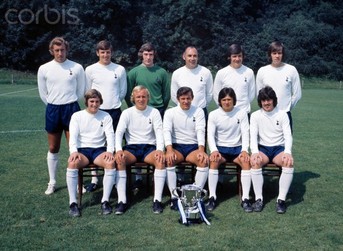 Two other of points to note about the kit from this period are that a short sleeved aertex shirt, as worn by England in the extreme heat of Mexico in the 1970 World Cup, was briefly experimented with early in the 1972/73 season and, an overt manufacturers logo appeared on the kit for the first time when worn on the shorts for the 1973 League Cup Final. Right - The Home shirt 1967 - 75 A navy blue Umbro Aztec away shirt with a white crew neck collar and cuffs, again matched with white shorts, was introduced from December 1962, initially with the slim line crest and then with the cockerel on a football crest in 1967. This kit was banned by the FA from 1969, and replaced with a new yellow change shirt with white crew neck collar and cuffs, and a navy cockerel badge. This was worn with either, white or navy blue shorts and plain yellow socks. 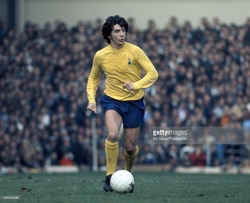 Notes from the first Spurs programme of the 1969/70 season explained why: “Supporters who travelled to Leeds on Saturday must have been surprised to see the team turn out in yellow shirts with a blue cockerel emblem. As Leeds wear white we were forced to change. Our change strip in recent years has been navy blue shirts, but this colour has now been banned by the League as it clashes with the referee's outfit.” These shirts were replaced by plain yellow shirts, worn with either navy blue or white shorts in 1971. Left - The Away strip 1971 - 75 In 1975, Spurs introduced their first away strip that was to incorporate a unique design and overt manufacturer’s logo. This was an all yellow kit with a navy blue button up collar and cuffs, and a pair of navy blue cadet stripes down the side of the shorts and around the socks turn over. 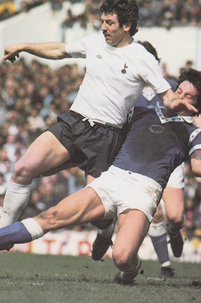 Their final kit for during this period is a true one off. In February 1977, Spurs played Leeds at Elland Road in an all royal blue kit, with white collar and cuffs and cadet stripe down the side of the shorts and on the socks turn over, but no club crest. Again I can find no reason for this, save that the normal all yellow change kit would have been hard to differentiate with Leeds’ all white kit on a black and white TV broadcast, however the match was never broadcast. Right - 1976 - 77 The summer of 1977 saw the signing of Spurs contract with Admiral Sportswear and an end of the old ways of supply and their forty year association with Umbro (for now) which had dated back to 1937. From now on the kits would be on a constant cycle of change as dictated by the commercial demands of the club and manufacturers’. Author - Tony Sealey
Part 2 - Will look at the years between the wars. Editor’s note – Tony is a lifelong Spurs supporter and has a wealth of knowledge regarding the club and we are delighted he has managed to find the time to share with us this series on his specialist subject, the kits worn by the team, as well as some of his many images. Please also remember he has offered to answer any questions you may have, you can add them in the comments below or on Facebook. Thank you.
1 Comment
keith
9/3/2017 01:17:53 pm
http://www.indiaspurs.com/blog/talking-tottenham-with-tony-sealey
Reply
Leave a Reply. |
Features
Flying Down to Rio History of T.H.F.C. Tribute to Bill Nicholson Talking Tottenham Early Legends The Road to Turin International Connections Hotspur Towers Most Read Articles
The 100 Year War Interview with Marina Sirtis A Long Dark Shadow By Royal Appointment School Report: An Insight into the Younger Eric Dier Dear Jimmy All Change At Spurs Hotspur Towers History Of THFC: Part 1 Passage to India: Rohan Rickets Thanks For The Memories Our Tommy Carroll The AVB Files: Part1 The Lilywhites You The Jury The Hand Of Hugo Connection - Argentina Creating a Reputation One Hotspur Archives
August 2018
Categories
All
|
 RSS Feed
RSS Feed
